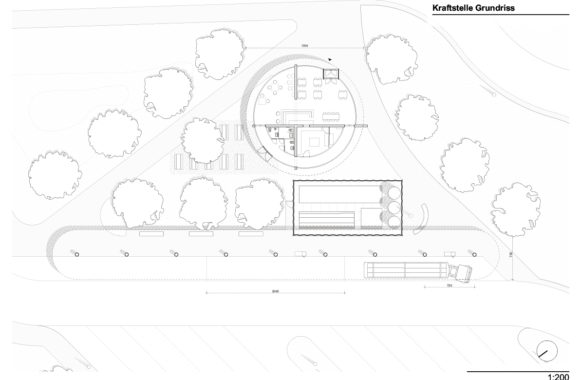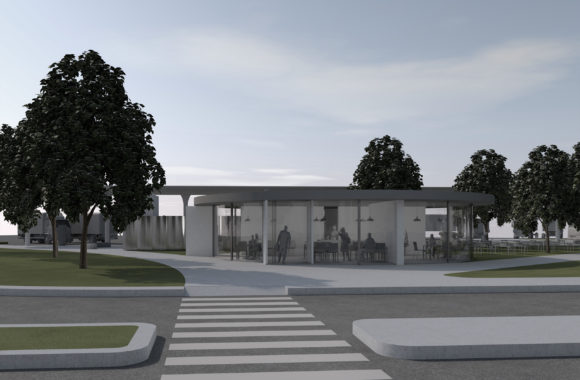
Bacherlorthesis: electric-/hydrogen filling station for cars and trucks at Kassel-Ost (German Autobahn A7). Due to the pandemic, the semester took completely place in digital manners. Accordingly the streamed presentations went mainly with visualisations and with screensized digital plans.
design task (in German).

The existing service area already has a filling station for fossil fuels. For the more modern energy sources, the necessary new infrastructure (pipelines/production, provision) was to be planned at predefined construction sites. For the technical challenges of the hydrogen refuelling stations, a tutor of the institute of automotive engineering also supervised the project. The focus of the individual plots, however, was on the elaboration of the structural systems. The several plots are connected by using wayfinding/traffic planning and supplemented by a multi-storey car park and restaurant.
The truck hydrogen filling station, called ‘Kraftstelle’, consists of covered dispensers, an electrolyser+pressure storage technology unit and an adjacent restaurant, which together constitute a triangular site. The supporting structure of the filling station is an exposed concrete ceiling resting on columns.
The HyTower is an automated car parking system for charging car batteries, but on the other hand also functions as a high point in the sense of an advertising board. The logo of the project partner, which is attached to the wooden slat façade, appears differently depending on the angle of view of the approaching driver. The building is errected as wood skeleton construction.

The new car filling station (‘PKW-Tanktstelle’) stands confidently between the existing filling station and the HyTower. Like at the truck service station, the supporting structure consists of a cast-in-place concrete flying roof. The structure was examined in more detail with regard to the production process, formwork type, exposed concrete quality, etc. and compiled in an in-depth study (see below)..


 The design was preceded by a design research of historical petrol stations, the results of which were compiled in this plan. It was mainly those icons with cantilevered concrete flying roofs from classical modernism and post-war modernism that were the reference for my structural design.
The design was preceded by a design research of historical petrol stations, the results of which were compiled in this plan. It was mainly those icons with cantilevered concrete flying roofs from classical modernism and post-war modernism that were the reference for my structural design.
Andreas Hofer, the artistic director and general manager of Stuttgart’s International Building Exhibition in 2027 is also convinced – well: almost: “That’s fine, but can you also do urban (projects)?”
bachelorthesis. Design team: Dennis Baganz
academic guidance: Hon.-Prof. Friedrich Grimm, Prof. Dipl.-Ing. José Luis Moro
further supervision: M.Sc. Janusch Töpler (structural design – KE Uni), Dr.-Ing. Michael Schier (automotive engineering – DLR)

























